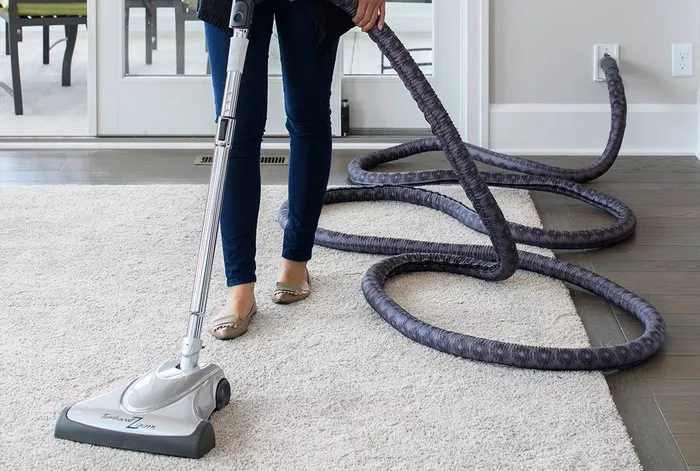Central vacuum systems represent a pinnacle in home cleaning technology, offering unparalleled convenience and efficiency compared to traditional vacuum cleaners. Unlike conventional vacuums, which require users to lug around heavy units and constantly switch power outlets, central vacuum systems are built directly into the home.
At the heart of the system lies the central unit, typically installed in a garage, basement, or utility room. This unit houses the motor and filtration system, providing powerful suction to remove dirt and debris from your living spaces. Connected to the central unit is a network of tubing, which runs through walls, floors, and ceilings, allowing for easy access to every corner of your home. Inlet valves strategically placed throughout the house provide connection points for vacuum hoses, while a variety of accessories—from brushes to crevice tools—ensure thorough cleaning of different surfaces and areas.
Installation and Setup
Installing a central vacuum system is a relatively straightforward process, but careful planning is essential to ensure optimal performance. Begin by selecting a suitable location for the central unit, preferably in a well-ventilated area away from living spaces to minimize noise. Next, strategically place inlet valves throughout the house, considering factors such as room layout and furniture placement. Once the inlet valves are in place, connect the tubing system to the central unit, ensuring a secure and airtight fit to maintain suction power.
Operating the System
Operating a central vacuum system is remarkably simple. To start, plug the vacuum hose into an inlet valve, ensuring a tight connection. Depending on the system, you may need to manually switch on the central unit using a control panel or activate it automatically by inserting the hose into the valve. Once the system is activated, you’re ready to start cleaning. Move the hose and attachments as needed, covering all areas of your home for a thorough clean.
Using Accessories
Central vacuum systems come with a range of accessories designed to tackle various cleaning tasks with ease. From floor brushes to upholstery tools, each attachment serves a specific purpose. When using accessories, ensure they are securely attached to the vacuum hose to prevent loss of suction. Experiment with different attachments to find the most effective combination for your cleaning needs, whether it’s removing pet hair from carpets or dusting ceiling fans.
Cleaning Technique
Achieving optimal results with a central vacuum system requires adopting the right cleaning technique. Start by tackling high-traffic areas and working your way towards less frequently used spaces. Use long, overlapping strokes to ensure thorough coverage, paying extra attention to corners and crevices where dirt tends to accumulate. Additionally, remember to adjust the suction power as needed, especially when transitioning between carpeted and hard surfaces.
Maintenance and Care
To keep your central vacuum system running smoothly, regular maintenance is key. Empty the central unit’s dirt canister or replace the disposable bag as needed to prevent clogs and maintain suction power. Check and clean the filters regularly to ensure optimal airflow and filtration efficiency. Inspect the tubing system for any blockages or leaks, and address them promptly to prevent damage to the system. Lastly, schedule professional maintenance checks at least once a year to address any potential issues before they escalate.
Troubleshooting
Despite their reliability, central vacuum systems may encounter occasional issues. Reduced suction power, strange noises, or malfunctioning inlet valves are common problems that users may face. If you encounter any of these issues, start by checking for clogs in the tubing system and ensuring all connections are secure. If the problem persists, consult the user manual for troubleshooting tips or contact a professional technician for assistance.
Safety Precautions
While central vacuum systems are generally safe to use, it’s essential to observe proper safety precautions to prevent accidents or injuries. Avoid vacuuming up large objects that could damage the system or pose a hazard. Keep hands and loose clothing away from moving parts to prevent entanglement. Before performing any maintenance tasks, disconnect power to the central unit to avoid electrical shocks or injuries.
Environmental Considerations
In addition to their convenience and efficiency, central vacuum systems offer several environmental benefits. By venting dust and allergens outdoors, they help improve indoor air quality, making them an ideal choice for allergy sufferers. Furthermore, central vacuum systems typically operate quieter than traditional vacuums, reducing noise pollution in the home environment.
Conclusion
In conclusion, mastering the central vacuum system requires a combination of understanding its components, proper installation and setup, and adopting the right cleaning techniques and maintenance practices. By following the guidelines outlined in this article, users can maximize the performance and longevity of their central vacuum system, ensuring a cleaner and healthier home environment for years to come. If you encounter any challenges along the way, don’t hesitate to reach out to professional technicians or refer to additional resources for assistance.

